2002 ISUZU AXIOM ignition
[x] Cancel search: ignitionPage 2069 of 2100

9J1±19
RESTRAINT CONTROL SYSTEM
DTC 17 Passenger Deployment Loop Open
D09R200001
Circuit Description:
When the ignition switch is turned ªONº, the SDM will
perform tests to diagnose critical malfunctions within
itself. Upon passing these tests, ªignition 1º, and
deployment loop voltages are measured to ensure they
are within their respective normal voltage ranges. During
ªContinuous Monitoringº diagnostics, a fixed amount of
current is flowing in the deployment loop. This produces
proportional voltage drops in the loop. By monitoring the
voltage difference between ªPassenger Bag Highº and
ªPassenger Bag Lowº, the SDM calculates the combined
resistance of the passenger air bag assembly, harness
wiring CKTs IB07±YEL/GRN and IB08±YEL/RED, and
connector terminal contact.
DTC Will Set When:
The voltage difference between ªPassenger Bag Highº
terminal ª15º and ªPassenger Bag Lowº terminal ª16º is
above or equal to a specified value for 500 milliseconds
during ªContinuous Monitoringº.
Action Taken:
SDM turns ªONº the ªAIR BAGº warning lamp and sets a
diagnostic trouble code.
DTC Will Clear When:
The voltage difference between ªPassenger Bag Highº
terminal ª15º and ªPassenger Bag Lowº terminal ª16º is
below a specified value for 500 milliseconds during
ªContinuous Monitoringº.
Page 2070 of 2100
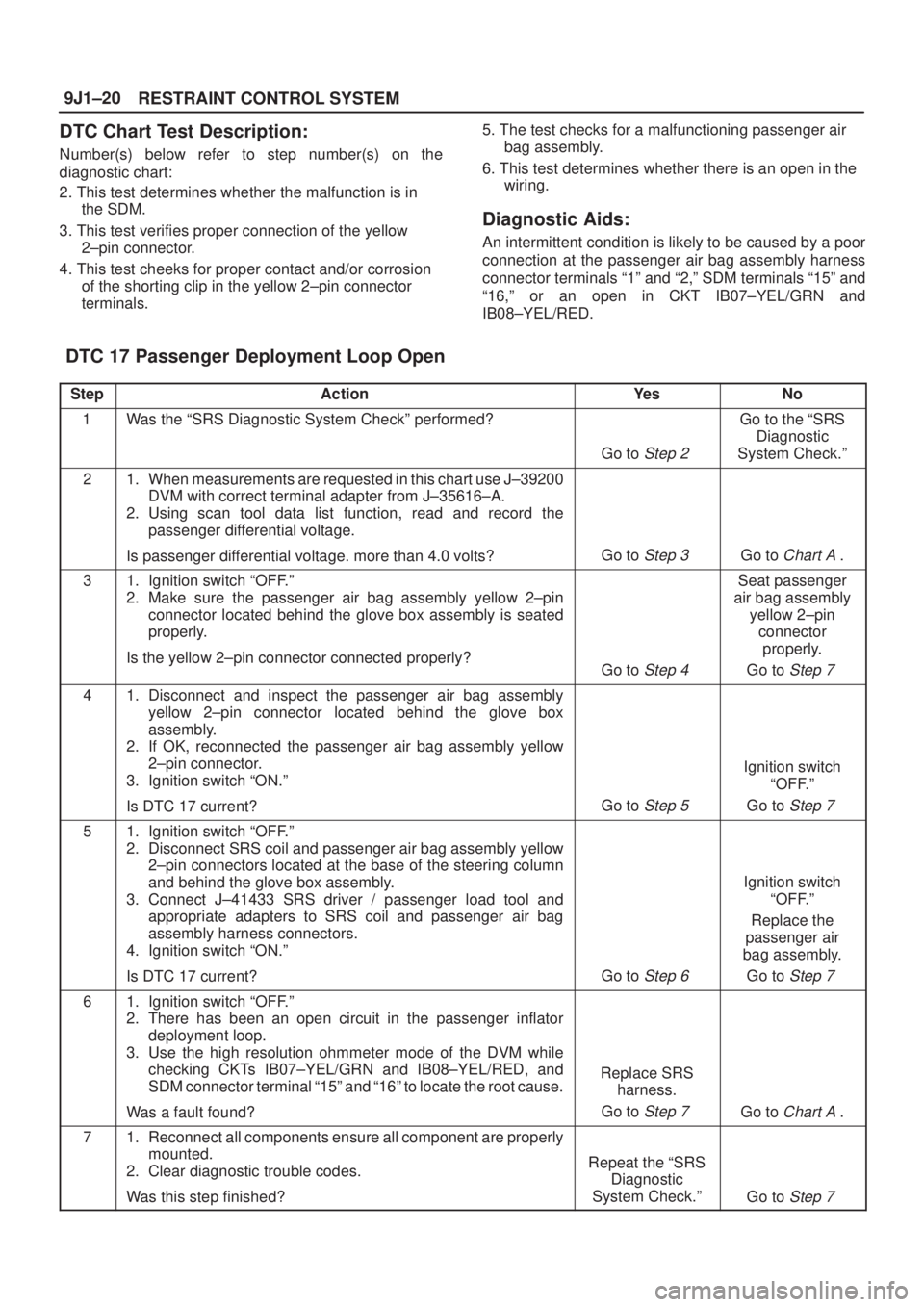
RESTRAINT CONTROL SYSTEM 9J1±20
DTC Chart Test Description:
Number(s) below refer to step number(s) on the
diagnostic chart:
2. This test determines whether the malfunction is in
the SDM.
3. This test verifies proper connection of the yellow
2±pin connector.
4. This test cheeks for proper contact and/or corrosion
of the shorting clip in the yellow 2±pin connector
terminals.5. The test checks for a malfunctioning passenger air
bag assembly.
6. This test determines whether there is an open in the
wiring.
Diagnostic Aids:
An intermittent condition is likely to be caused by a poor
connection at the passenger air bag assembly harness
connector terminals ª1º and ª2,º SDM terminals ª15º and
ª16,º or an open in CKT IB07±YEL/GRN and
IB08±YEL/RED.
DTC 17 Passenger Deployment Loop Open
StepActionYe sNo
1Was the ªSRS Diagnostic System Checkº performed?
Go to Step 2
Go to the ªSRS
Diagnostic
System Check.º
21. When measurements are requested in this chart use J±39200
DVM with correct terminal adapter from J±35616±A.
2. Using scan tool data list function, read and record the
passenger differential voltage.
Is passenger differential voltage. more than 4.0 volts?
Go to Step 3 Go to Chart A .
31. Ignition switch ªOFF.º
2. Make sure the passenger air bag assembly yellow 2±pin
connector located behind the glove box assembly is seated
properly.
Is the yellow 2±pin connector connected properly?
Go to Step 4
Seat passenger
air bag assembly
yellow 2±pin
connector
properly.
Go to
Step 7
41. Disconnect and inspect the passenger air bag assembly
yellow 2±pin connector located behind the glove box
assembly.
2. If OK, reconnected the passenger air bag assembly yellow
2±pin connector.
3. Ignition switch ªON.º
Is DTC 17 current?
Go to Step 5
Ignition switch
ªOFF.º
Go to
Step 7
51. Ignition switch ªOFF.º
2. Disconnect SRS coil and passenger air bag assembly yellow
2±pin connectors located at the base of the steering column
and behind the glove box assembly.
3. Connect J±41433 SRS driver / passenger load tool and
appropriate adapters to SRS coil and passenger air bag
assembly harness connectors.
4. Ignition switch ªON.º
Is DTC 17 current?
Go to Step 6
Ignition switch
ªOFF.º
Replace the
passenger air
bag assembly.
Go to
Step 7
61. Ignition switch ªOFF.º
2. There has been an open circuit in the passenger inflator
deployment loop.
3. Use the high resolution ohmmeter mode of the DVM while
checking CKTs IB07±YEL/GRN and IB08±YEL/RED, and
SDM connector terminal ª15º and ª16º to locate the root cause.
Was a fault found?
Replace SRS
harness.
Go to
Step 7 Go to Chart A .
71. Reconnect all components ensure all component are properly
mounted.
2. Clear diagnostic trouble codes.
Was this step finished?
Repeat the ªSRS
Diagnostic
System Check.º
Go to Step 7
Page 2071 of 2100
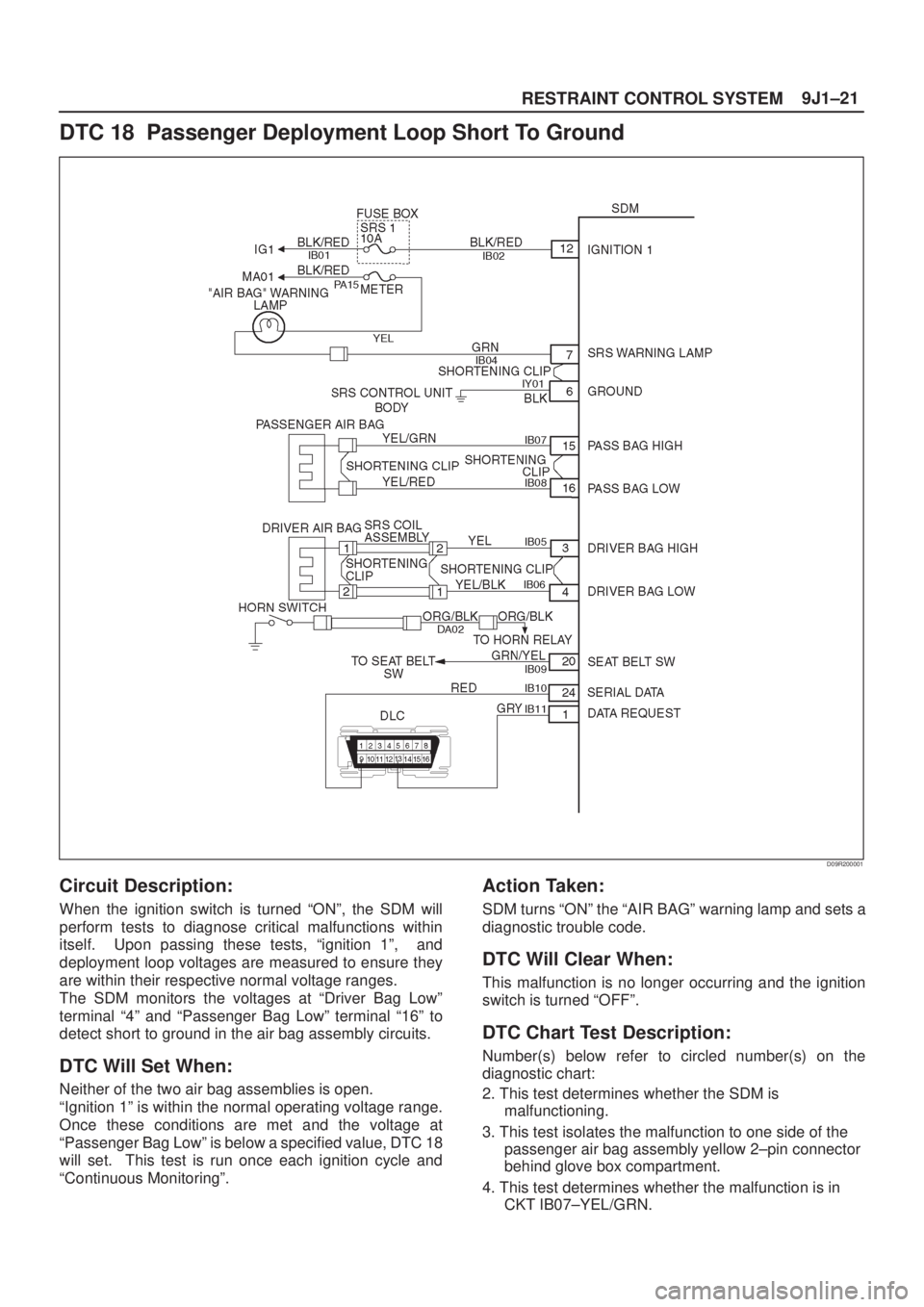
9J1±21
RESTRAINT CONTROL SYSTEM
DTC 18 Passenger Deployment Loop Short To Ground
D09R200001
Circuit Description:
When the ignition switch is turned ªONº, the SDM will
perform tests to diagnose critical malfunctions within
itself. Upon passing these tests, ªignition 1º, and
deployment loop voltages are measured to ensure they
are within their respective normal voltage ranges.
The SDM monitors the voltages at ªDriver Bag Lowº
terminal ª4º and ªPassenger Bag Lowº terminal ª16º to
detect short to ground in the air bag assembly circuits.
DTC Will Set When:
Neither of the two air bag assemblies is open.
ªIgnition 1º is within the normal operating voltage range.
Once these conditions are met and the voltage at
ªPassenger Bag Lowº is below a specified value, DTC 18
will set. This test is run once each ignition cycle and
ªContinuous Monitoringº.
Action Taken:
SDM turns ªONº the ªAIR BAGº warning lamp and sets a
diagnostic trouble code.
DTC Will Clear When:
This malfunction is no longer occurring and the ignition
switch is turned ªOFFº.
DTC Chart Test Description:
Number(s) below refer to circled number(s) on the
diagnostic chart:
2. This test determines whether the SDM is
malfunctioning.
3. This test isolates the malfunction to one side of the
passenger air bag assembly yellow 2±pin connector
behind glove box compartment.
4. This test determines whether the malfunction is in
CKT IB07±YEL/GRN.
Page 2072 of 2100
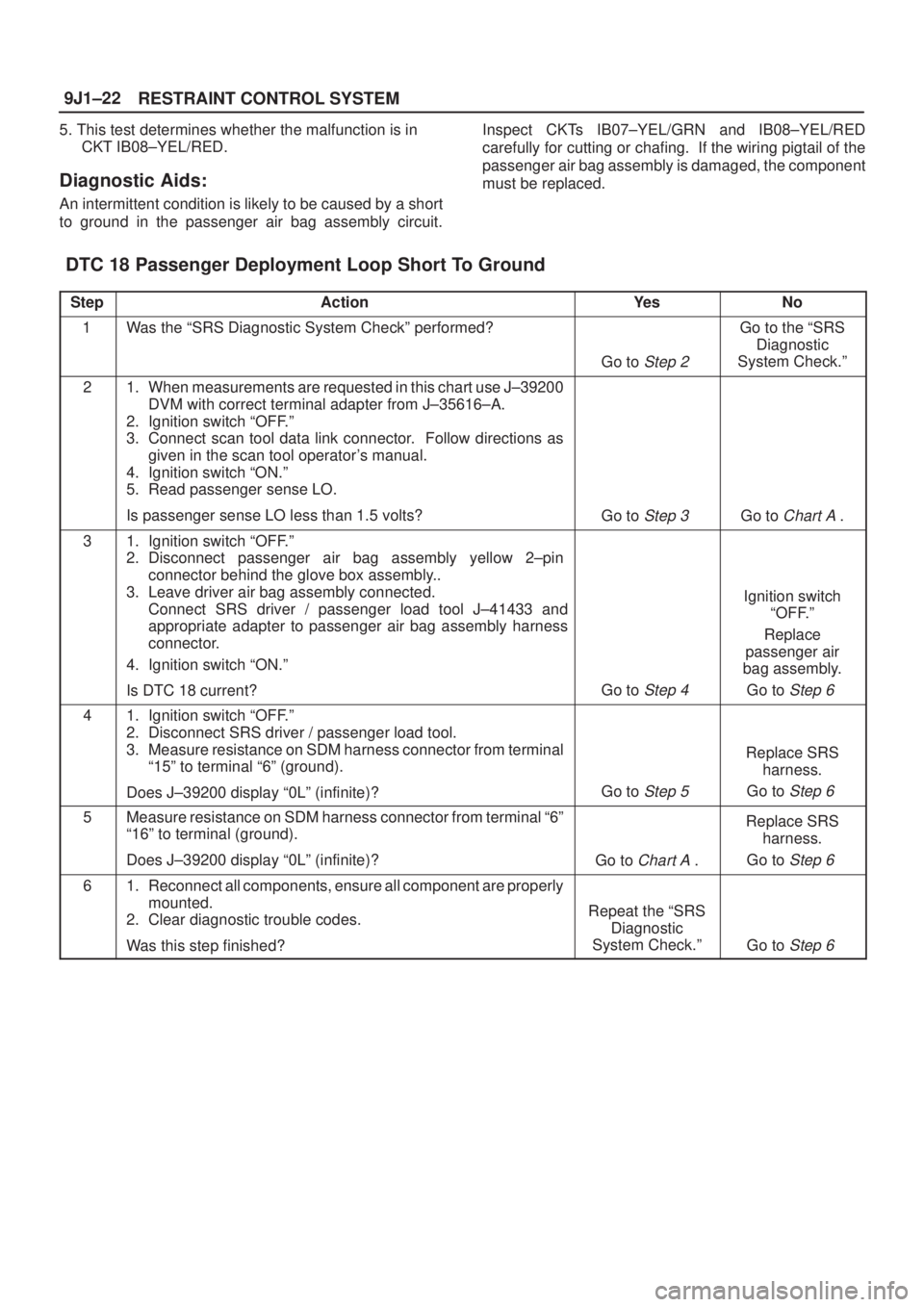
RESTRAINT CONTROL SYSTEM 9J1±22
5. This test determines whether the malfunction is in
CKT IB08±YEL/RED.
Diagnostic Aids:
An intermittent condition is likely to be caused by a short
to ground in the passenger air bag assembly circuit.Inspect CKTs IB07±YEL/GRN and IB08±YEL/RED
carefully for cutting or chafing. If the wiring pigtail of the
passenger air bag assembly is damaged, the component
must be replaced.
DTC 18 Passenger Deployment Loop Short To Ground
StepActionYe sNo
1Was the ªSRS Diagnostic System Checkº performed?
Go to Step 2
Go to the ªSRS
Diagnostic
System Check.º
21. When measurements are requested in this chart use J±39200
DVM with correct terminal adapter from J±35616±A.
2. Ignition switch ªOFF.º
3. Connect scan tool data link connector. Follow directions as
given in the scan tool operator's manual.
4. Ignition switch ªON.º
5. Read passenger sense LO.
Is passenger sense LO less than 1.5 volts?
Go to Step 3 Go to Chart A .
31. Ignition switch ªOFF.º
2. Disconnect passenger air bag assembly yellow 2±pin
connector behind the glove box assembly..
3. Leave driver air bag assembly connected.
Connect SRS driver / passenger load tool J±41433 and
appropriate adapter to passenger air bag assembly harness
connector.
4. Ignition switch ªON.º
Is DTC 18 current?
Go to Step 4
Ignition switch
ªOFF.º
Replace
passenger air
bag assembly.
Go to
Step 6
41. Ignition switch ªOFF.º
2. Disconnect SRS driver / passenger load tool.
3. Measure resistance on SDM harness connector from terminal
ª15º to terminal ª6º (ground).
Does J±39200 display ª0Lº (infinite)?
Go to Step 5
Replace SRS
harness.
Go to
Step 6
5Measure resistance on SDM harness connector from terminal ª6º
ª16º to terminal (ground).
Does J±39200 display ª0Lº (infinite)?
Go to Chart A .
Replace SRS
harness.
Go to
Step 6
61. Reconnect all components, ensure all component are properly
mounted.
2. Clear diagnostic trouble codes.
Was this step finished?
Repeat the ªSRS
Diagnostic
System Check.º
Go to Step 6
Page 2073 of 2100
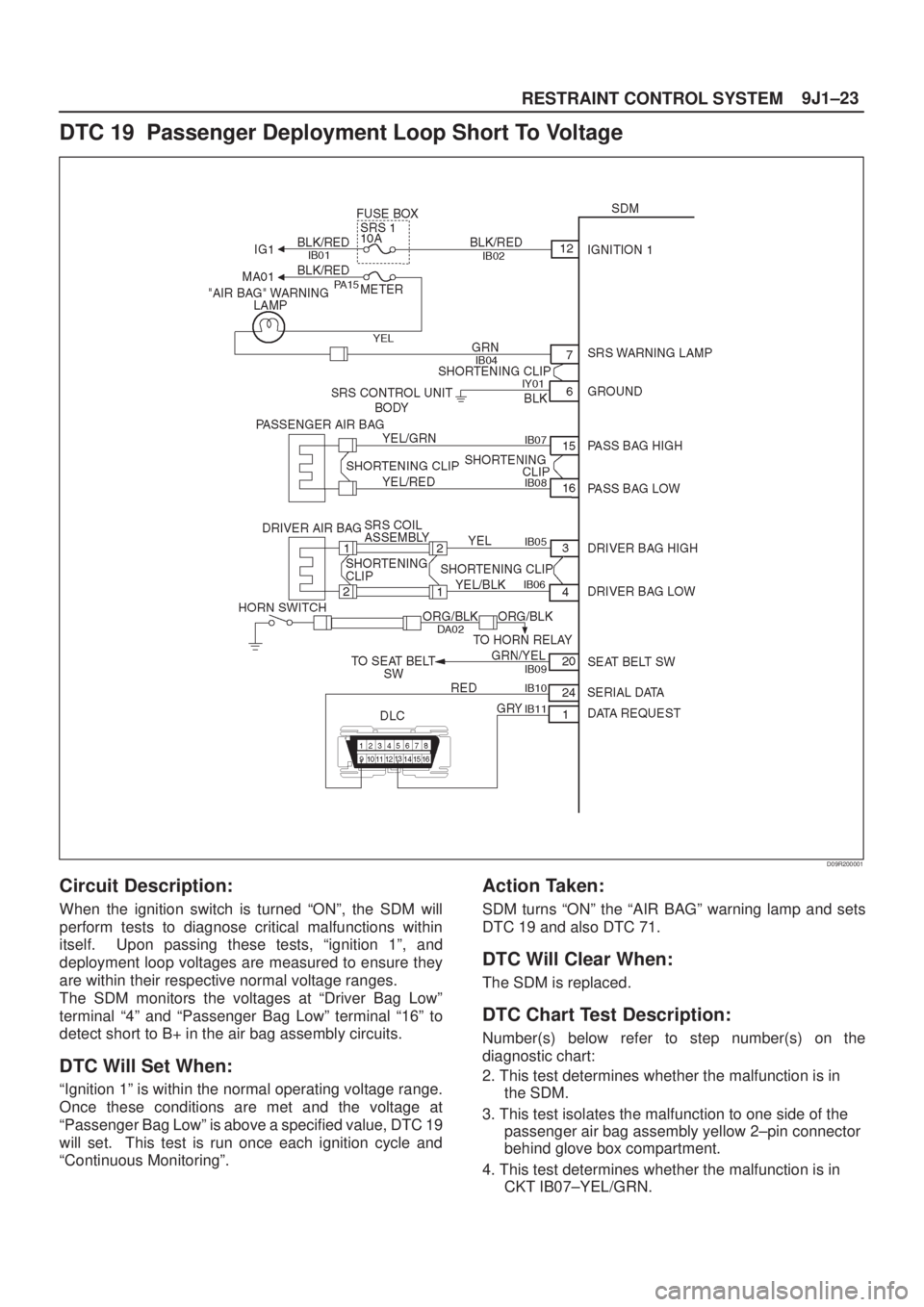
9J1±23
RESTRAINT CONTROL SYSTEM
DTC 19 Passenger Deployment Loop Short To Voltage
D09R200001
Circuit Description:
When the ignition switch is turned ªONº, the SDM will
perform tests to diagnose critical malfunctions within
itself. Upon passing these tests, ªignition 1º, and
deployment loop voltages are measured to ensure they
are within their respective normal voltage ranges.
The SDM monitors the voltages at ªDriver Bag Lowº
terminal ª4º and ªPassenger Bag Lowº terminal ª16º to
detect short to B+ in the air bag assembly circuits.
DTC Will Set When:
ªIgnition 1º is within the normal operating voltage range.
Once these conditions are met and the voltage at
ªPassenger Bag Lowº is above a specified value, DTC 19
will set. This test is run once each ignition cycle and
ªContinuous Monitoringº.
Action Taken:
SDM turns ªONº the ªAIR BAGº warning lamp and sets
DTC 19 and also DTC 71.
DTC Will Clear When:
The SDM is replaced.
DTC Chart Test Description:
Number(s) below refer to step number(s) on the
diagnostic chart:
2. This test determines whether the malfunction is in
the SDM.
3. This test isolates the malfunction to one side of the
passenger air bag assembly yellow 2±pin connector
behind glove box compartment.
4. This test determines whether the malfunction is in
CKT IB07±YEL/GRN.
Page 2074 of 2100
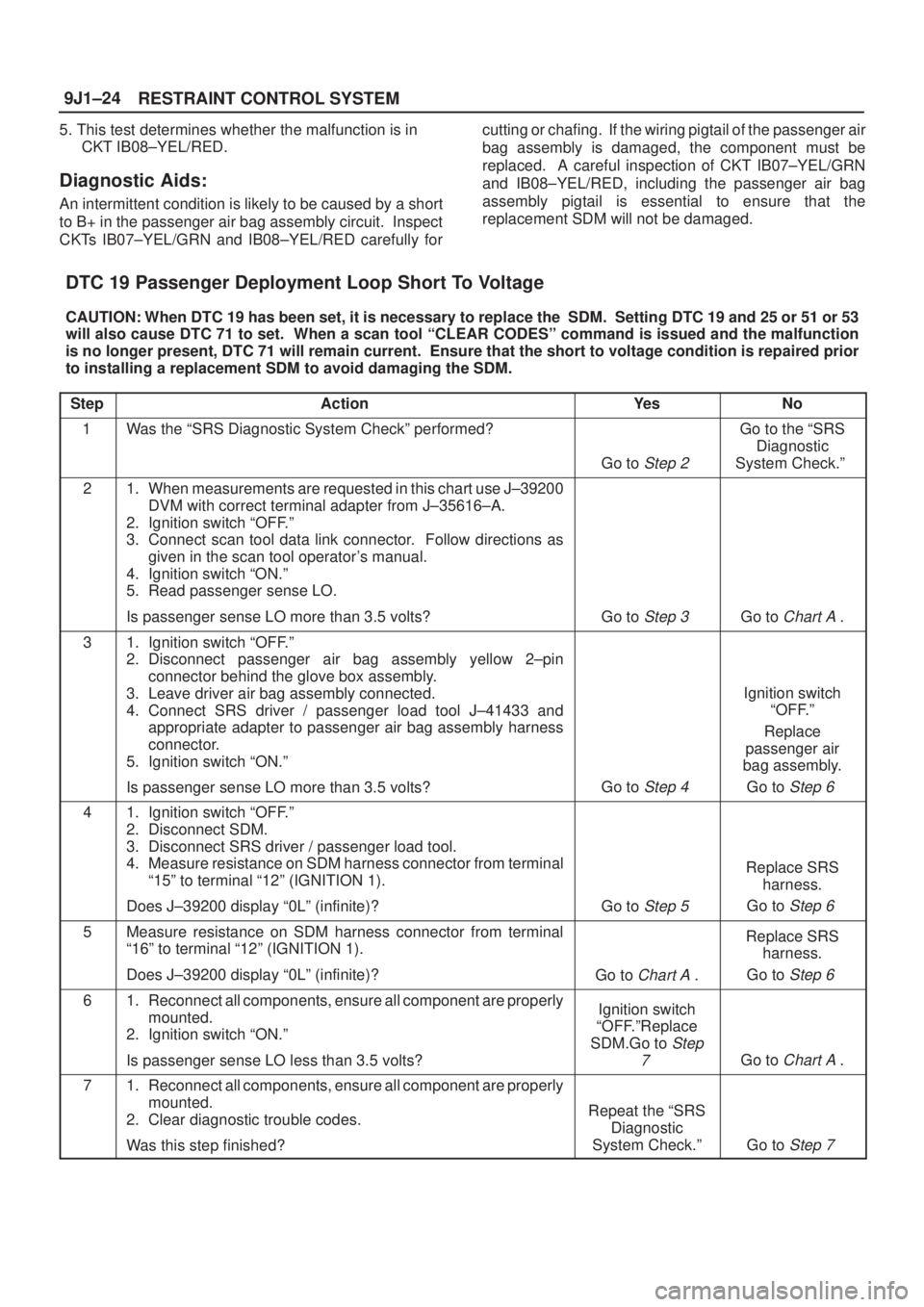
RESTRAINT CONTROL SYSTEM 9J1±24
5. This test determines whether the malfunction is in
CKT IB08±YEL/RED.
Diagnostic Aids:
An intermittent condition is likely to be caused by a short
to B+ in the passenger air bag assembly circuit. Inspect
CKTs IB07±YEL/GRN and IB08±YEL/RED carefully forcutting or chafing. If the wiring pigtail of the passenger air
bag assembly is damaged, the component must be
replaced. A careful inspection of CKT IB07±YEL/GRN
and IB08±YEL/RED, including the passenger air bag
assembly pigtail is essential to ensure that the
replacement SDM will not be damaged.
DTC 19 Passenger Deployment Loop Short To Voltage
CAUTION: When DTC 19 has been set, it is necessary to replace the SDM. Setting DTC 19 and 25 or 51 or 53
will also cause DTC 71 to set. When a scan tool ªCLEAR CODESº command is issued and the malfunction
is no longer present, DTC 71 will remain current. Ensure that the short to voltage condition is repaired prior
to installing a replacement SDM to avoid damaging the SDM.
Step
ActionYe sNo
1Was the ªSRS Diagnostic System Checkº performed?
Go to Step 2
Go to the ªSRS
Diagnostic
System Check.º
21. When measurements are requested in this chart use J±39200
DVM with correct terminal adapter from J±35616±A.
2. Ignition switch ªOFF.º
3. Connect scan tool data link connector. Follow directions as
given in the scan tool operator's manual.
4. Ignition switch ªON.º
5. Read passenger sense LO.
Is passenger sense LO more than 3.5 volts?
Go to Step 3 Go to Chart A .
31. Ignition switch ªOFF.º
2. Disconnect passenger air bag assembly yellow 2±pin
connector behind the glove box assembly.
3. Leave driver air bag assembly connected.
4. Connect SRS driver / passenger load tool J±41433 and
appropriate adapter to passenger air bag assembly harness
connector.
5. Ignition switch ªON.º
Is passenger sense LO more than 3.5 volts?
Go to Step 4
Ignition switch
ªOFF.º
Replace
passenger air
bag assembly.
Go to
Step 6
41. Ignition switch ªOFF.º
2. Disconnect SDM.
3. Disconnect SRS driver / passenger load tool.
4. Measure resistance on SDM harness connector from terminal
ª15º to terminal ª12º (IGNITION 1).
Does J±39200 display ª0Lº (infinite)?
Go to Step 5
Replace SRS
harness.
Go to
Step 6
5Measure resistance on SDM harness connector from terminal
ª16º to terminal ª12º (IGNITION 1).
Does J±39200 display ª0Lº (infinite)?
Go to Chart A .
Replace SRS
harness.
Go to
Step 6
61. Reconnect all components, ensure all component are properly
mounted.
2. Ignition switch ªON.º
Is passenger sense LO less than 3.5 volts?Ignition switch
ªOFF.ºReplace
SDM.Go to
Step
7
Go to Chart A .
71. Reconnect all components, ensure all component are properly
mounted.
2. Clear diagnostic trouble codes.
Was this step finished?
Repeat the ªSRS
Diagnostic
System Check.º
Go to Step 7
Page 2075 of 2100
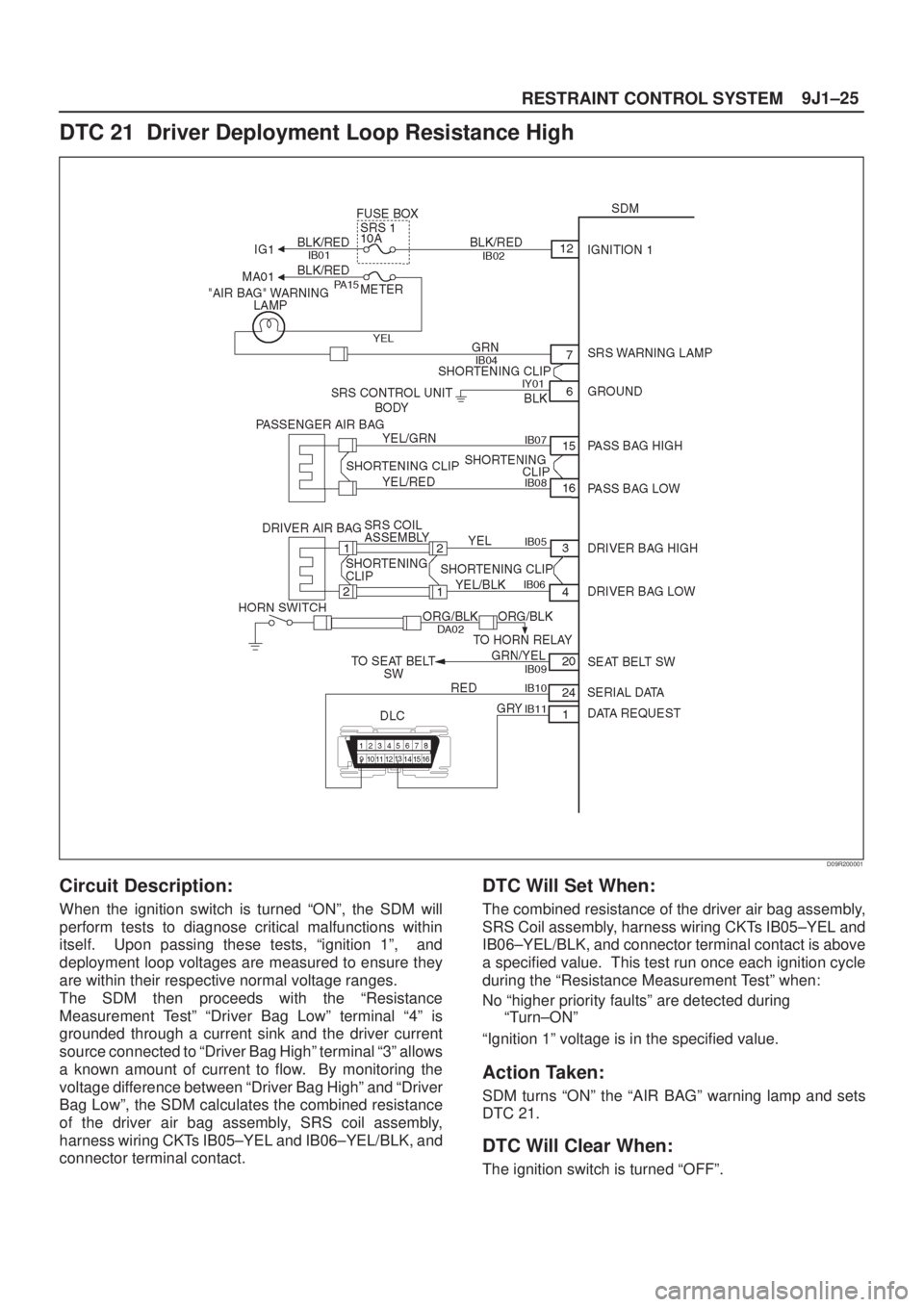
9J1±25
RESTRAINT CONTROL SYSTEM
DTC 21 Driver Deployment Loop Resistance High
D09R200001
Circuit Description:
When the ignition switch is turned ªONº, the SDM will
perform tests to diagnose critical malfunctions within
itself. Upon passing these tests, ªignition 1º, and
deployment loop voltages are measured to ensure they
are within their respective normal voltage ranges.
The SDM then proceeds with the ªResistance
Measurement Testº ªDriver Bag Lowº terminal ª4º is
grounded through a current sink and the driver current
source connected to ªDriver Bag Highº terminal ª3º allows
a known amount of current to flow. By monitoring the
voltage difference between ªDriver Bag Highº and ªDriver
Bag Lowº, the SDM calculates the combined resistance
of the driver air bag assembly, SRS coil assembly,
harness wiring CKTs IB05±YEL and IB06±YEL/BLK, and
connector terminal contact.
DTC Will Set When:
The combined resistance of the driver air bag assembly,
SRS Coil assembly, harness wiring CKTs IB05±YEL and
IB06±YEL/BLK, and connector terminal contact is above
a specified value. This test run once each ignition cycle
during the ªResistance Measurement Testº when:
No ªhigher priority faultsº are detected during
ªTurn±ONº
ªIgnition 1º voltage is in the specified value.
Action Taken:
SDM turns ªONº the ªAIR BAGº warning lamp and sets
DTC 21.
DTC Will Clear When:
The ignition switch is turned ªOFFº.
Page 2076 of 2100
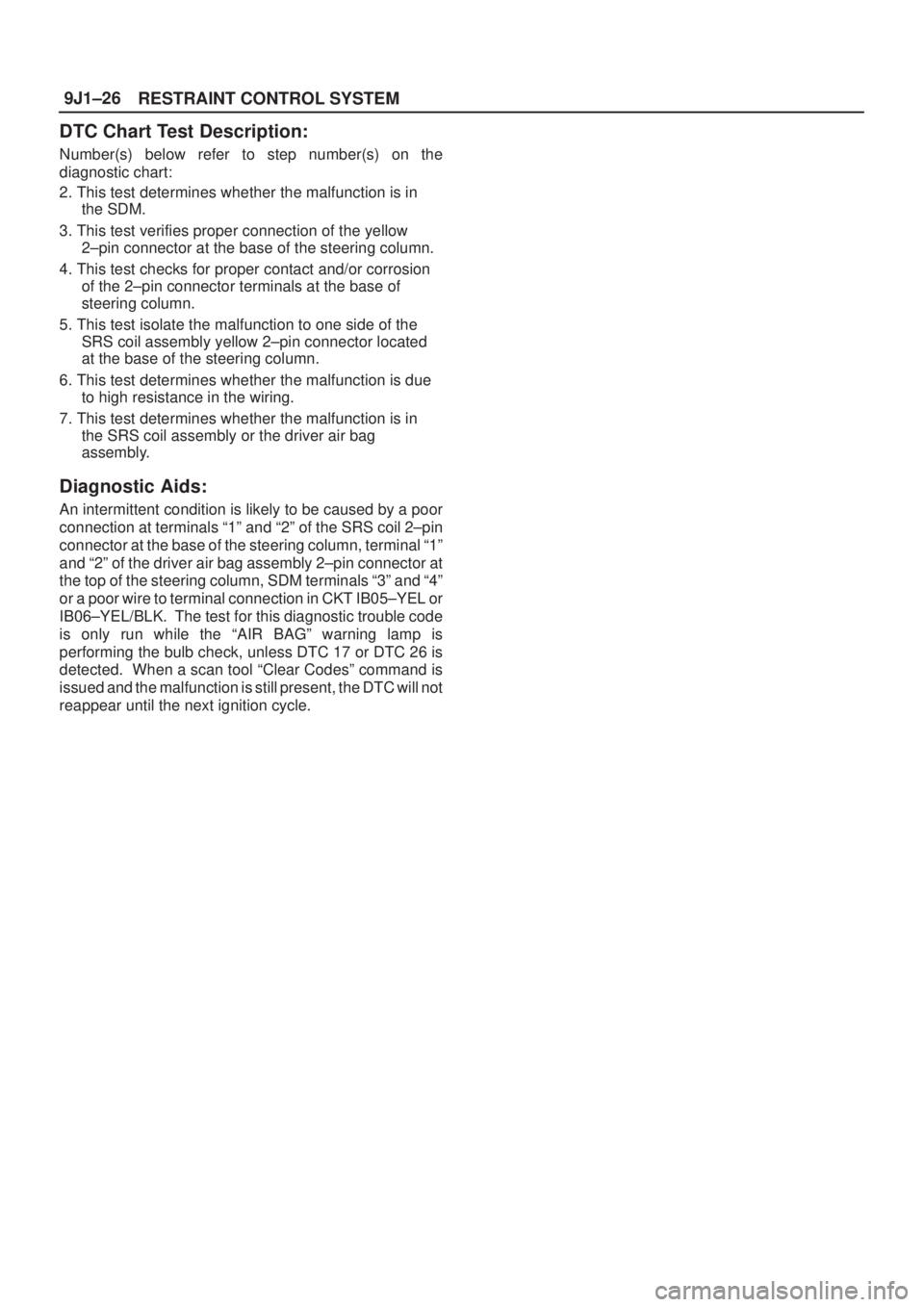
RESTRAINT CONTROL SYSTEM 9J1±26
DTC Chart Test Description:
Number(s) below refer to step number(s) on the
diagnostic chart:
2. This test determines whether the malfunction is in
the SDM.
3. This test verifies proper connection of the yellow
2±pin connector at the base of the steering column.
4. This test checks for proper contact and/or corrosion
of the 2±pin connector terminals at the base of
steering column.
5. This test isolate the malfunction to one side of the
SRS coil assembly yellow 2±pin connector located
at the base of the steering column.
6. This test determines whether the malfunction is due
to high resistance in the wiring.
7. This test determines whether the malfunction is in
the SRS coil assembly or the driver air bag
assembly.
Diagnostic Aids:
An intermittent condition is likely to be caused by a poor
connection at terminals ª1º and ª2º of the SRS coil 2±pin
connector at the base of the steering column, terminal ª1º
and ª2º of the driver air bag assembly 2±pin connector at
the top of the steering column, SDM terminals ª3º and ª4º
or a poor wire to terminal connection in CKT IB05±YEL or
IB06±YEL/BLK. The test for this diagnostic trouble code
is only run while the ªAIR BAGº warning lamp is
performing the bulb check, unless DTC 17 or DTC 26 is
detected. When a scan tool ªClear Codesº command is
issued and the malfunction is still present, the DTC will not
reappear until the next ignition cycle.